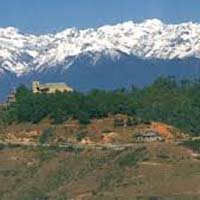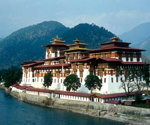Cost Includes:
• Hotel in Thimpu on F/B on twin sharing basis
• Sightseeing as per itinerary
• Man Power: Guide, Cook, Sherpa, Kitchen boys, helper, porters
• Food during the trek 3 meals a day
• 2 men tent, mattress, all camping gear except sleeping bag, dining tent, kitchen tent, toilet tent, table & chairs
• Hotel-airport-hotel transfers
Cost Excludes:
• Flight: Kathmandu-Paro-Kathmandu as per itinerary
• Personal equipments
• High risk medical insurance
• International air ticket, airport tax
• Alcoholic beverages & telephone calls
• Visa fees, emergency rescue evacuations if needed
VISA
Foreign travellers must possess a visa for Bhutan which is granted initially for 14 days. While the actual visa is stamped on arrival in Bhutan upon payment of US $20, visitors need to obtain visa clearance from the Tourism Authority of Bhutan (TAB) in advance. The visa can be extended in Thimpu for up to six months. The operator making your travel arrangements will handle the official formalities.
GETTING THERE AND AROUND
Druk Air, Bhutan's airline, operates flights to Paro from Bangkok, Kolkata, Dhaka, Kathmandu and New Delhi. The overland entry/exit point is from the Indian state of West Bengal into Phuntsholing in southwest Bhutan. Phuntsholing is four hours’ drive from Bagdogra, the nearest Indian airport, and seven hours' drive from both Gangtok (Sikkim) and Darjeeling. The drive from Phuntsholing to Thimpu takes six hours.
Transport within the country is provided by tour operators who have their own fleet of luxury buses. All major places of interest are connected by paved roads.
GENERAL INFO
Bhutan has a strip of plain in the south, a network of valleys in the central parts and over 7,000-m high mountains in the north.
Tariff: The Department of Tourism has set minimum tariffs which are different for the high and low seasons. Individuals and groups of less than four persons must pay a surcharge. The rates are the same for both cultural tours and treks.
Season: March-May and September-November are the high season months, while June, July and December-February comprise the low season. Bring cotton or light woolen wear in summer (maximum temperature 30 degrees Celsius) and heavy woolens and down jacket in winter (minimum 1.1 degrees Celsius).
Adventure: Trekking and mountaineering.
Accommodation: Modern hotels are available in Thimpu. The outlying areas have comfortable resorts and lodges.
Religion/Culture
The State religion is Drukpa Kagyupa a branch of Mahayana Buddhism. It has been institutionalized in the Dratshang (Central Monk Body), headed by the Je Khenpo (Chief Abbot) who is chosen from among the most learned Lamas and enjoys an equal rank with the King. Bhutan is the only country in the world to have adopted Mahayana Buddhism in its Tantric form as its official religion. The Buddhist faith has played and continues to play a fundamental role in the cultural, ethical and sociological development of Bhutan and its people. It permeates all strands of secular life.
Climate
Summer (June-August) is pleasant but wet due to the monsoons .Winter (December-February) is cold with temperatures dropping below zero. The daytime is pleasant with clear blue skies. Spring (March-May) is the best time of the year-pleasant weather with plenty of greenery, Autumn (September-November) is similar to spring but warmer.
People
Bhutanese are of a Mongolian decent who originally migrated to this the country in the 7th Century AD. A nomadic and pastoral society at first, they gradually turned to agriculture in the fertile valleys. There are three main ethnic groups - the Ngalongs in the western and central regions are the descendants of Tibetan immigrants who arrived in Bhutan from the 9th century. The Sharchops who live in the east of the country, are recognized as the original inhabitants of Bhutan. The third group is known as Lhotshampas. They represent the Nepali speaking ethnic group. The total population of Bhutan is about 600,000.
Dzongs:
These massive fortress-monasteries decorate most hill-tops and valleys. They serve as the administrative headquarters and are the focus of secular and religious authority in each district.






.jpg)
